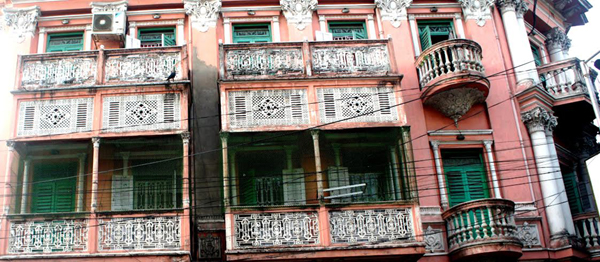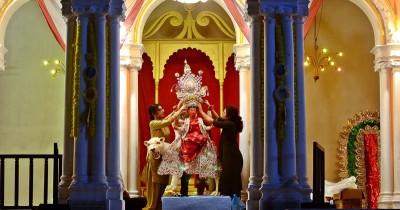
Amazing grace
.jpg) A visit to Kolkata from Down Under while accompanying her businessman husband proved to be fortuitous both for Joanne Taylor and grand old houses in north Kolkata. An architectural historian, author and photographer from Sydney, Taylor was fascinated by the “strange, hybrid houses of north Kolkata”, more often than not lying neglected or ignored as the world went by.
A visit to Kolkata from Down Under while accompanying her businessman husband proved to be fortuitous both for Joanne Taylor and grand old houses in north Kolkata. An architectural historian, author and photographer from Sydney, Taylor was fascinated by the “strange, hybrid houses of north Kolkata”, more often than not lying neglected or ignored as the world went by.
Scholars in colonial history cite Kolkata (Calcutta) as having some of the finest built environ in the world from that era. After all, it was here that the British Indian empire found a foothold beginning with the rather low profile landing of Job Charnock, an official with the East India Company, on the banks of the Hooghly a little over three centuries ago; later, Kolkata served as the empire’s capital till it shifted to Delhi in 1911.
North Kolkata, focus of Taylor’s book, is today seen as ‘old and dilapidated’ compared to the new kid in town - south Kolkata, but it was the hub of cultural and social activities in colonial times, and ironically, also where political discourses took place on how to throw out the colonialists.
Taylor was in Kolkata recently for the launch of her book The Great Houses of Calcutta , co-authored with Jon Lang, born and brought up in Kolkata, who now teaches architecture in Australia.
.jpg)
Recalls the author, “With architectural history as my forte, as I explored the old neighbourhoods of Kolkata, I was amazed by the beauty, and quirkiness, of some of the old zemindar palaces and rich businessmen’s houses. I tried to find out more and read up, but sadly I couldn’t find much archival material.” That led to her own journey of discovery, not “very easy though” and resulted in her first book, the award winning The Forgotten Palaces of Calcutta (Niyogi, 2006). The challenge was also to connect with the families who have been living there from the time of their ancestors, “...as an outsider, probing, entering their private space,’ but she was surprised by the warmth and hospitality they extended.
It can be noted that in both the books, Taylor spells the city as Calcutta because it is about a time when the new spelling ‘Kolkata’ (likewise for many other Indian cities), was yet to come by.
Influential people in the colonial era, traders and businessmen, besides the zemindars built houses, and today, besides a few, “…are largely forlorn reminders of a way of life, aspirations and aesthetic values,” as Taylor observes.
.jpg) Some of the best representative buildings that come to mind in this part of Kolkata is the Marble Palace of the Mullick family, the Sovabazar palace, the Jorasanko palace of the Tagores, Lahabari of the Laha family, the Burdwan house in south Kolkata etc.
Some of the best representative buildings that come to mind in this part of Kolkata is the Marble Palace of the Mullick family, the Sovabazar palace, the Jorasanko palace of the Tagores, Lahabari of the Laha family, the Burdwan house in south Kolkata etc.
Those who have seen Satyajit Ray’s Charulata, English language The Namesake and more recently Shoojit Sircar’s hit Hindi film Piku, among others, shot in old Kolkata houses would recognise the red-oxide floors, the green-shuttered windows, wide porches on the ground floor, the intricate cornices, elaborate wrought-iron grills etc. which showcase the 19th century houses.
.jpg)
This leads to the question, ‘what is modern?’ in an ongoing debate the world over. In the 18th and 19th century Kolkata, these houses, a fusion of many styles, Corinthian, Gothic, Neo-Classical etc. which were regarded as very modern those days.
Today, as globalization touches almost every aspect of our society, including in the uniformity in design of living quarters, a dedicated band of historians, built environmentalists and citizens who value heritage are trying to bring into focus the need to preserve houses what reflect sensibilities of a time, a certain grace, which would disappear otherwise, be it in the Portuguese style houses in Goa, art-deco buildings in Mumbai, the tea garden bungalows in the North East, or Kolkata’s colonial heritage structures.
Well-known author, Sahitya Akademi awardee, Amit Chaudhuri has been passionately writing on the impending destruction of this unique heritage of Kolkata. “They represent a Bengali-European style that is not seen elsewhere,” he observes. He feels that not only the huge houses of north Kolkata, those in southern part which saw many successful Bengali professionals building their houses display a unique style calling for rescue from promoters.
.jpg) Fund for preserving the houses and support from the government to save houses of heritage value from getting demolished are, of course, of utmost importance. With support from eminent persons from the field of arts and culture Chaudhuri has launched an online campaign “ Save Calcutta’s architectural heritage “ to draw attention of the concerned authorities on the Avaaz.org community petition platform which has attracted thousands of signatories . Nobel Laureate Amartya Sen has also validated this effort to draw attention of the city’s powers- that- be to stop the relentless move to erase buildings from the city’s landscape to be replaced by glass and chromium multi-storey buildings.
Fund for preserving the houses and support from the government to save houses of heritage value from getting demolished are, of course, of utmost importance. With support from eminent persons from the field of arts and culture Chaudhuri has launched an online campaign “ Save Calcutta’s architectural heritage “ to draw attention of the concerned authorities on the Avaaz.org community petition platform which has attracted thousands of signatories . Nobel Laureate Amartya Sen has also validated this effort to draw attention of the city’s powers- that- be to stop the relentless move to erase buildings from the city’s landscape to be replaced by glass and chromium multi-storey buildings.
“Kolkata fascinates me, it has become my second home,” Taylor says even as she starts exploring heritage buildings, their state, and individuality in other parts of India, “which can be a huge and challenging job considering the country’s size and diversity in built environ,” she says.
Support Our Journalism
We cannot do without you.. your contribution supports unbiased journalism
IBNS is not driven by any ism- not wokeism, not racism, not skewed secularism, not hyper right-wing or left liberal ideals, nor by any hardline religious beliefs or hyper nationalism. We want to serve you good old objective news, as they are. We do not judge or preach. We let people decide for themselves. We only try to present factual and well-sourced news.







